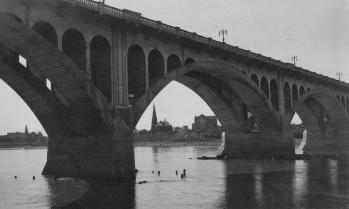
Bridges allow the movement of people and transported goods to cross over obstacles and hazards, thereby saving considerable time and expense as well as ensuring safety. The railway, with its transcontinental and local lines, required numerous bridges to cross major rivers and minor streams. These early bridges, made of timber, were usually rebuilt using steel. North Battleford and Nipawin are examples of major railway bridges; Swift Current is an example of a community developed at a site of the railway bridge on the CPR mainline. Railway companies are responsible for the safety and maintenance of their bridges. The Department of Highways is responsible for the construction and maintenance of 850 bridges on the provincial highway network. There are an additional 2,200 bridges on rural and urban municipal roads in Saskatchewan; most of these are short, but about 20% are larger span bridges. Several bridges are located at former ferry sites. Saskatoon has become known locally as the City of Bridges: in 1908 it had three railway bridges and one for vehicles; now there are two railway bridges and five vehicle bridges, with two more proposed for a future transportation corridor.
Bob Ivanochko